You may have seen one of the newest additions to Presbee’s gallery, which is a start-up business template. The template is perfect if you are unsure of how to stage a start-up pitch presentation or even if you class yourself as an expert in the field, as we have added some notes from the presentation guru Guy Kawasaki to each slide. We thought it would be good to give you a run through of our new template and highlight how you can make it work for your presentation design.
Who is Guy Kawasaki?
Guy Kawasaki originally worked for Apple back in 1984 and he worked within the Macintosh division of the company. He is credited with popularizing the term evangelist marketing if you were wondering. He’s published 12 books including one named The Art of Social Media, and he is definitely one knowledgeable guy.
Have you heard of the 10 – 20 – 30 rule?
The 10 – 20 – 30 rule in essence, means stick to just 10 slides, make your presentation no longer than 20 minutes long and use no less than size 30 font. But why? In his blog post, Kawasaki explains his thought process, and in this post, we will explain how you could potentially use this concept by altering Presbee’s business start-up presentation template. However, although our business start-up pitch template does have only 10 slides, we’ve been a little more relaxed with the other parts of the rule and instead just focused on Kawasaki’s more detailed advice when it comes to the structure of your presentation.
Presentation Guru Kawasaki sees 10 slides as the right amount simply because your audience will struggle to comprehend anything more, especially if you introduce a new concept on each slide. When you’re flicking through the template in the gallery I would argue it doesn’t feel particularly rushed and instead seems like the perfect length, if you are spending the correct amount of time talking through each slide.
The first of the start-up pitch deck’s slides asks you to describe ‘the pain you are alleviating or the pleasure you are going to provide’. Essentially, you need to describe the current situation and how you are going to improve it. Opening with this description puts it into your audience’s mind from the outset and hopefully encourages a positivity that will surround your following slides.
This is continued in the second slide where you present your ‘value proposition’. In your pitch, you can really emphasise the positive outcomes of your solution and also its strength. You may have some sceptical faces in the audience at this point but you may have already won some audience members over. And when you move onto your next slide you can hit your audience with the innovative idea or plan you have to change their current situation. As we have quoted on the template presentation, Kawasaki has stressed that the less complicated and crowded information on the slide the better. If you have a prototype now is the point to pull it out, if you have an informative video or at the very least an image or example – depending on what it is you are pitching – then give it to your audience.
And now assuming you have your audience on board with your idea – and even if you don’t there’s still time – you need to go into detail about your business model and how you are expecting money to be changing hands in the future. On the following slide, you can go into further detail as to who your specific market is and how you are going to be targeting them. All of this is going to come at a cost so you could also briefly break this down. Remember to be concise, give them the necessary facts but don’t spend half an hour going through every figure. If they need to, they can ask for more detailed information through questions after your pitch.
Finally, you need to acknowledge the competition in the market and prove you are aware of it and show that you have strategies to make your concept stand out. As mentioned before, you don’t need to go into massive amounts of detail, just enough to prove your acumen to your audience. And as the template shows, go over the current situation of your business and how it has worked to far. A slide introducing your team is key as well as slides covering financial projections and a brief description of how the business has run to date.
The start-up pitch template is based on ideas taken from Guy Kawasaki’s work and his blog and we believe that it is a great place to start with any start-up pitch presentation and of course, can be adapted and altered in a million ways through Presbee.
What do you think of the Kawasaki model? Have you ever tried to model your presentation around the 10-20-30 model? Are you currently creating a start-up pitch presentation?
You can find out more about Presbee here, and have a look at our business start-up template here.


 Protect your Intellectual Property.
Protect your Intellectual Property.